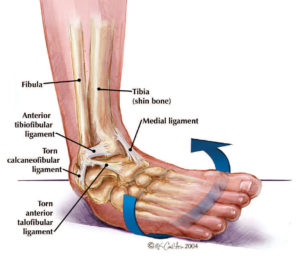The Unexpected Twist: Unraveling Ankle Sprain Mysteries
August 16 2025
Don’t let a simple “twist” turn into a chronic pain! Ankle sprains are often underestimated, leading to long-term instability. In our latest article, we dive into why immediate attention and a comprehensive rehab plan are crucial for a full, lasting recovery. Read more to learn how to heal smarter, not harder!
#AnkleSprain #Podiatry #FootHealth #InjuryRecovery PhysicalTherapy #HealthTips #FFLC
Dr. Sahiba Singh, DPM, AACFAS
Kevin Lam, DPM, FACFAS
Ankle sprains are among the most common injuries, affecting millions of people each year, from elite athletes to the casual walker. As a podiatrist, I frequently see the immediate aftermath and , unfortunately, the lingering consequences of these seemingly simple injuries. While many view a sprained ankle as a minor inconvenience, it’s a complex injury with the potential for long-term complications if not properly addressed.
athletes to the casual walker. As a podiatrist, I frequently see the immediate aftermath and , unfortunately, the lingering consequences of these seemingly simple injuries. While many view a sprained ankle as a minor inconvenience, it’s a complex injury with the potential for long-term complications if not properly addressed.
Let’s begin by understanding what an ankle sprain truly is. It’s not just a “twist.” A sprain occurs when the ligaments, the tough, fibrous bands of connective tissue that stabilize the ankle joint, are stretched or torn beyond their normal limits. The most common type is an inversion sprain, where the foot rolls inward, damaging the ligaments on the outside of the ankle – specifically the anterior talofibular ligament (ATFL), calcaneofibular ligament (CFL), and sometimes the posterior talofibular ligament (PTFL). Eversion sprains, where the foot rolls outward, are less common but often more severe, affecting the deltoid ligament on the inside of the ankle.
The symptoms of an ankle sprain can vary widely depending on the severity. Immediately, you’ll likely experience pain, which can range from mild discomfort to excruciating agony. Swelling is almost always present, often developing rapidly due to internal bleeding and fluid accumulation. Bruising may appear within hours or days, indicating blood leakage from damaged vessels. Tenderness to the touch, especially over the injured ligaments, is another tell-tale sign. Depending on the extent of the injury, you might also have difficulty bearing weight, a feeling of instability, or even hear a “pop” at the moment of injury.
The Podiatric Approach to Diagnosis
From a podiatric perspective, accurate diagnosis is paramount. While many people self-diagnose an ankle sprain, it’s crucial to rule out more serious injuries, such as fractures. During an examination, I’ll carefully assess the range of motion, pinpoint areas of tenderness, and perform specific stress tests to evaluate the integrity of the ligaments. X-rays are often necessary to exclude a fracture, especially if there’s significant pain, swelling, or and instability to bear weight. In some cases, an MRI may be recommended to assess the extent of soft tissue damage, including ligament tears, tendon injuries, or cartilage damage, particularly if symptoms persist despite initial treatment.
Immediate Treatment and Rehabilitation
Once a diagnosis of an ankle sprain is confirmed, treatment typically follows the RICE protocol: Rest, Ice, Compression and Elevation.
- REST is essential to prevent further injury and allow the healing process to begin. This might mean crutches for a few days, especially if weight-bearing is painful.
- ICE applied for 15-20 minutes every 2-3 hours helps reduce swelling and pain by constricting blood vessels.
Beyond the initial RICE protocol, rehabilitation is critical for a full recovery and to prevent future sprains. This is where many individuals fall short, leading to chronic ankle instability. A structured rehabilitation program, often guided by a physical therapist, will focus on three key areas:
Restoring Range of Motion: Gentle exercises to improve flexibility and restore normal ankle movement.
- Strengthening: Targeting the muscles around the ankle and lower leg to provide dynamic support to the joint. This includes exercises like calf raises, resistance band exercises, and eccentric training.
- Proprioception and Balance: This is perhaps the most overlooked yet vital aspect.
- Proprioception is the body’s ability to sense its position in space. Ankle sprains disrupt the proprioceptive nerve endings in the ligaments, leading to a diminished sense of balance. Exercises like single-leg standing, balance board training, and walking on uneven surfaces are crucial for retraining these pathways and improving stability.
Preventing Chronic Ankle Instability
As a podiatrist, I often encounter patients who have suffered recurrent ankle sprains. This is frequently due to inadequate rehabilitation after the initial injury. Chronic ankle instability can manifest as a persistent feeling of the ankle “giving way”, recurrent sprains with minimal provocation, or chronic pain and swelling. If conservative measures fail to address chronic instability, intervention may be considered to repair of reconstruct the damaged ligaments. This is typically a last resort, but it can be highly effective in restoring stability and function.
Proactive Steps for Ankle Health
Preventing ankle sprains is always preferable to treating them. Here are some key recommendations:
- Appropriate Footwear: Wear supportive shoes that fit well and are appropriate for your activity. Avoid high heels on uneven surfaces.
- Warm-up and Cool-down: Always warm up before physical activity and cool down afterward to prepare your muscles and ligaments.
- Strengthening and Balance Exercises: Incorporate ankle-strengthening and balance exercises into your regular fitness routine, even if you’ve never had a sprain.
- Listen to Your Body: If you feel pain or discomfort in your ankle, stop the activity and rest. Pushing through pain can exacerbate injury.
- Taping or Bracing: If you have a history of ankle sprains, consider prophylactic taping or wearing an ankle brace during high-risk activities.
In conclusion, while an ankle sprain might seem like a common and minor injury, it demands respect and proper management. As a podiatrist, my goal is not just to treat the immediate symptoms but to ensure a comprehensive recovery that minimizes the risk of long-term complications. Ignoring an ankle sprain or rushing the rehabilitation process can lead to chronic pain, instability, and a diminished quality of life.
If you’ve recently sprained your ankle, or if you’re experiencing chronic ankle pain and instability from a  past injury, it’s time to take action. Schedule an appointment with your podiatrist today to ensure a proper diagnosis and a personalized treatment plan. Your ankles support your entire body – give them the care they deserve!
past injury, it’s time to take action. Schedule an appointment with your podiatrist today to ensure a proper diagnosis and a personalized treatment plan. Your ankles support your entire body – give them the care they deserve!
If your are experiencing pain from an ankle sprain, contact Dr. Singh’s office at (239) 430-3668 (FOOT) or visit www.NaplesPodiatrist.com to schedule an appointment.
Serving Southwest Florida Since 2005, Family Foot & Leg Center has multiple convenient locations throughout Collier, Lee, Charlotte, and Sarasota Counties. Offering pediatric to geriatric family care: Ingrown Toenails, Heel Pain, Bunions, Foot / Ankle Arthritis Pain, Plantar Fasciitis, Foot / Ankle Surgery, Custom Orthotics, and Diabetic Wound Care. In office X-rays, ultrasounds, and minor surgical suite exam rooms. Practice powered by EMR and advanced technologies.
Home of the Lam Minimally Invasive No-Scar Bunion Surgery! Come Discover Why Patients Love Our 5-Star Foot & Ankle Care!
Same Day Appointments! Easy Online Appointment Scheduling.

 Fax: (239) 692-9436
Fax: (239) 692-9436 Tel: 239-430-3668
Tel: 239-430-3668